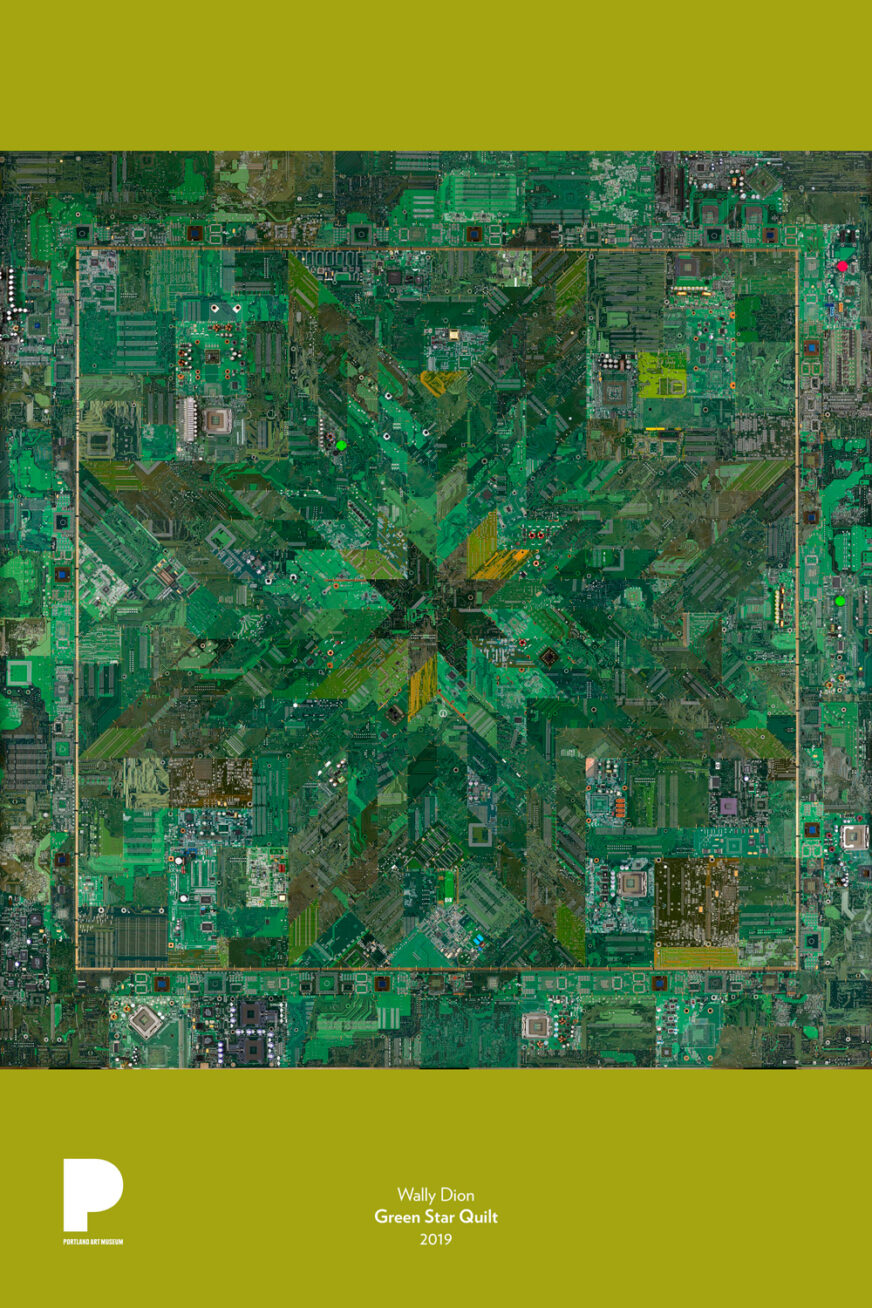
Wally Dion is a Canadian artist working across multiple disciplines including painting, drawing, and sculpture. As an artist of Saulteaux ancestry (Yellow Quill First Nation), Dion confronts issues surrounding identity and power through representational and abstract geometric works.
Green Star Quilt is a sculpture that resembles the fabric squares of a traditional quilt, but is made of sewn-together recycled computer circuit boards, brass wire, and copper tubing. Its star pattern “evokes the quilting tradition practiced among many Native communities in the United States and Canada,” notes Kathleen Ash-Milby, Curator of Native American Art.
The crafting and gifting of star quilts is a symbolic and longstanding tradition in Indian Country. To give or receive a star quilt is an honor; they are used to mark a significant life event such as the birth of a baby, marriage, or memorials, as well as ceremonies and other celebrations. Quilts and blankets (handwoven, commercially produced, or made from trade cloth) replaced hide robes in the nineteenth century, especially after Native communities lost access to hunting grounds and white frontiersmen hunted the buffalo to near extinction.
The star quilt originated at the onset of reservation life in the 1850s among the Northern Plains tribes, including the Lakota, Ojibwa, Crow and others, and today can be seen in Indigenous communities across the United States and Canada. Women played a significant role in this quilting tradition. Previously, women had processed and prepared buffalo and other hide robes, but the hides were mainly painted by men. The making of star quilts by women today is an act of cultural continuity. The eight-pointed star represents the morning star, which has many meanings in different Indigenous communities. Over the decades women began to integrate additional community-specific cultural symbols into the overall design. With his star quilts, Wally Dion recognizes and honors “the crucial role women played within Indigenous communities: as nurturers, gatherers, teachers, and leaders.”
At the same time, Dion radically transforms the star quilt through his choice of materials: recycled computer motherboards. “The resulting sculptural work plays with our expectations,” Ash-Milby writes. “Soft, comforting cloth has been replaced with rigid material and the surface is visually complex with a multitude of mechanical, sharp protrusions.” Dion’s quilts reference the importance of craft and skilled labor, while reflecting his long-standing interest in “an element of accountability to the land and extraction of its resources.” Where have these materials come from? What history of exploitation of land and people do they carry? Where do these materials go once they’ve outlived their function? His quilts “speak to the opportunity, and potential menace, presented by technology.”
Dion finds computer circuit boards themselves richly symbolic. They are “the hieroglyphics of our time. People who use and depend upon their continued functioning know next to nothing about their inner language, or code. For many people, computer circuitry is as enigmatic as the symbols carved into the side of a 3,000-year-old temple and yet we have enormous faith in their ability to furnish us with our lifestyles.”
Dion’s Green Star Quilt insists that we acknowledge Indigenous histories and contemporary presence and that we think critically about our use of and dependence on technology. His work not only contributes to a broad conversation in the art world about identity and power; it participates in the larger pan- American struggle of Indigenous peoples to be recognized culturally, economically, and politically by settler societies.
Discussion and activities
- What do you see when you look at this object? Make a list of all the possibilities. What patterns and colors do you notice? What is our perspective or relation to the image? What materials do you observe?
- Think about the title of this artwork: Green Star Quilt. In what ways is this work like or unlike a quilt? How would it feel if you tried to use Green Star Quilt as a blanket? How does this work invite you to think differently about both quilts and computers? Why might Wally Dion have chosen to bring together this traditional art form and this modern technology?
- Compare Dion’s Green Star Quilt to Lynn Aldrich’s Biophilia, another Poster Project work made from recycled or repurposed materials. How does each artist address concerns about the environment through their artwork?
- Create a sculpture with found objects—everyday materials you have at home or in the recycle bin. Will your sculpture be abstract or representational? How much will you conceal or reveal the nature of your materials?